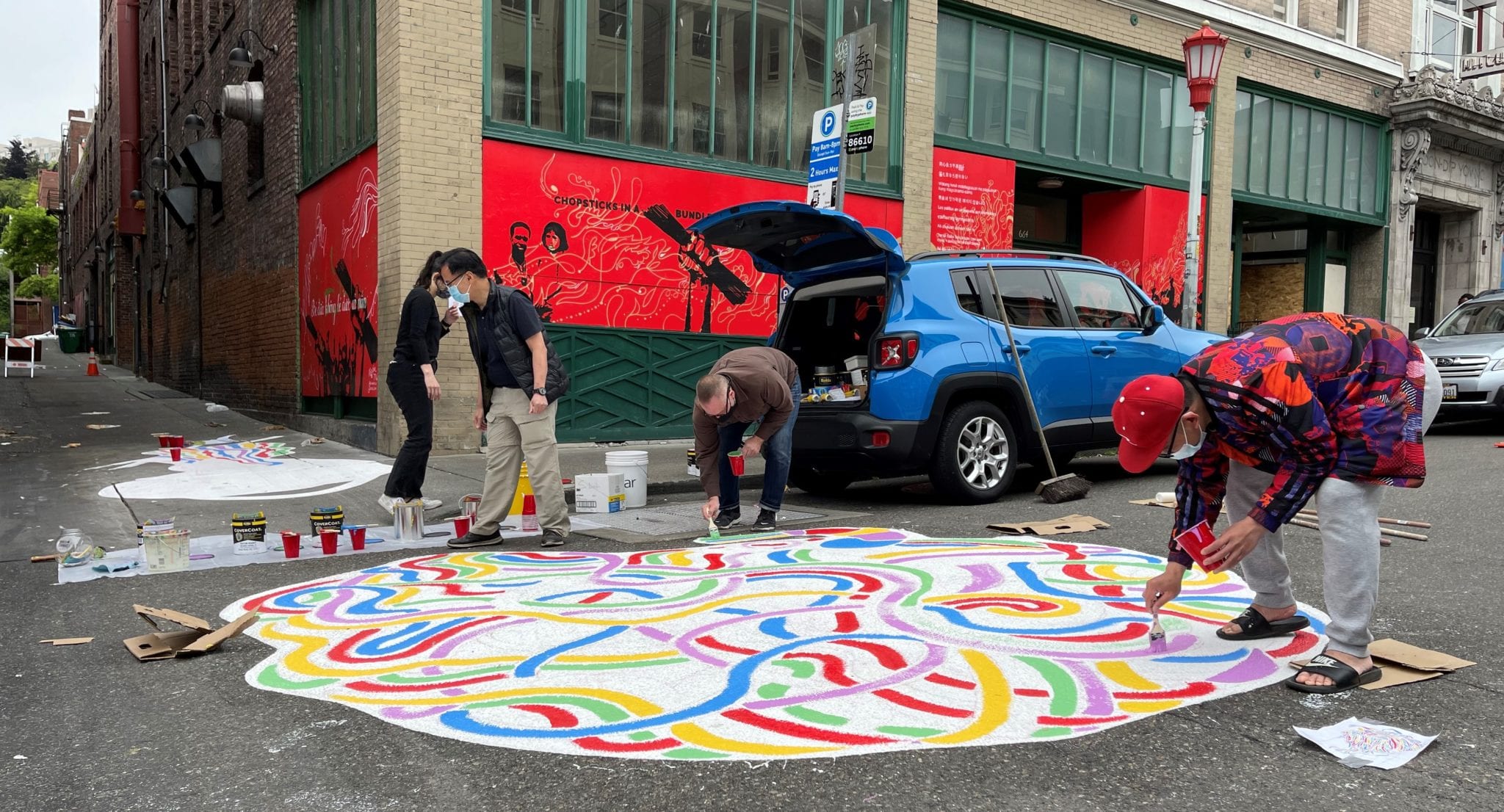
This post was co-authored by Erika Lindsay and is also posted on the Art Beat Blog.
Come see the new SLURP! mural in Chinatown International District (CID)!
Designed by local artist Akira Ohiso and installed with technical assistance from muralist Angelina Villalobos, the vibrant new SLURP! mural includes eight segments that meander through Maynard Alley near South King St.
This mural is inspired by noodles, stepping stones, the immigrant journey, and the diversity of intersecting cultures inhabiting the Chinatown International District today. Each noodle cluster alludes to geographic locations, the circuitous route of immigration, and safe passage through the space. Landing on each cluster promotes this journey. Viewers are invited to appreciate the diversity of the neighborhood through vibrant colors, movement, and a memorable experience.
– Akira Ohiso, artist who designed SLURP
Initiated by the community, the mural is the result of a collaboration between the Maynard Alley Partnership, Seattle Chinatown International District Preservation Development Authority (SCIDpda), Chinatown International District Business Improvement Area (CIDBIA), several neighborhood businesses and individuals, the Seattle Together Initiative, Seattle Office of Arts & Culture (ARTS), and Seattle Department of Transportation (SDOT) working together to reimagine Maynard Alley as a vibrant, community-focused pedestrian space.
The CID, which consists of Chinatown, Japantown, and Little Saigon, is both a historic district and a lively neighborhood with bustling small businesses, diverse residential demographics, well-used parks, a community center, social service agencies, medical clinics, and cultural institutions.
Last week we shared a brief history of the CID to help us understand and appreciate how the Asian Pacific Islander communities have overcome some of the harshest systems of racism and created their own vibrant microcosms.

Maynard Alley is one of two historic alleyways in the CID that the community has worked to revitalize in recent years. The other being Canton Alley.
For more than a century, people have lived and worked in residential units and storefronts off the alley. The historic buildings that line the alley hold layered stories from the neighborhood and people who have called the CID home over the years.

One of the gems on Maynard Alley is the Louisa Hotel. Built in 1909, the Louisa Hotel was built to house Chinese, Japanese, and Filipino laborers while they waited for work in Alaskan canneries. The hotel was also the site of two speakeasies, the Blue Heaven and The Club Royale, and Seattle’s first Chinese bakery.
The Maynard Alley Partnership has worked with local businesses, community members, and the City to make the alleyway a safe and inviting destination for people to gather, eat, shop, and strengthen the community.
With funding from the 1% for Arts program, the City is proud to support the community’s vision and install the new piece of artwork. The Public Art program integrates artworks and the ideas of artists into a variety of public settings, advancing Seattle’s reputation as a cultural center for innovation and creativity.
The City worked closely with the Maynard Alley Partnership and a number of businesses in the neighborhood to ensure that the artist and artwork would speak to the unique community, strengthen connections, highlight and the culture and history of the CID.
Last week, Ohiso, Villalobos, SDOT and ARTS staff, and about a dozen talented volunteers painted the mural on the alleyway and S King St.
Dahvee Enciso, who coordinates installing all of our ground murals, shared this was one of the most fun projects he’s worked on. “There was so much community support and gracious hospitality! Shop owners stopped by throughout the day to see our progress and brought sweet treats to the amazing volunteers who were helping us paint. Everyone’s cheery spirits reflected the vibrant colors in the mural.”

Come see the fresh mural for yourself!
Follow the meandering mural through the alley and ponder the unique cuisines, histories, and experiences that each segment of mural represents. While you’re there, visit one of the mom and pop shops, enjoy a bubble tea, or stop in one of the many restaurants for a delicious bowl of noodles. You can also stop by the Wing Luke Museum and nearby businesses to pick up free stickers of the mural as well.
Visit SeattleChinatownID.com for shops, restaurants, and places to visit in Seattle’s CID.
To learn more about the historic CID, check out these resources
- Chinatown/International District Facebook Page
- Seattle Chinatown International District Preservation and Development Authority
- Chinatown International District Business Improvement Area
- History Link: Seattle Neighborhoods: Chinatown-International District
- National Park Service: Seattle Chinatown Historic District
- Louisa Hotel: Club Royale Murals
Additionally, our friends at the Seattle Department of Neighborhoods are hosting a series of profiles and stories to amplify and honor people, businesses, organizations, and projects connected to the history of Seattle’s API community. And we invite you to read our brief history of the CID and resilient API communities.